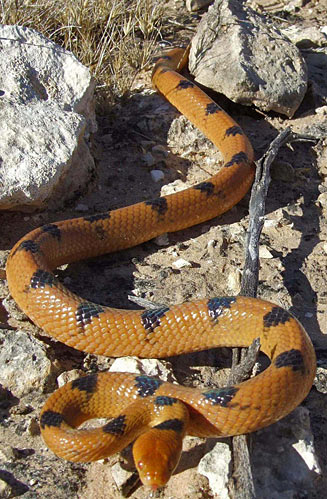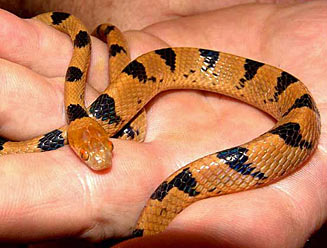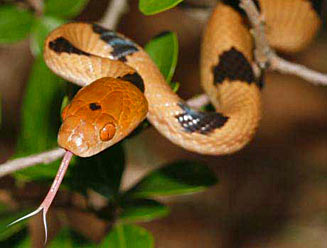|
Telescopus semiannulatus semiannulatus (Eastern tiger
snake)
Oostlelike tierslang [Afrikaans]
Life >
Eukaryotes
>
Opisthokonta >
Metazoa
(animals) > Bilateria > Deuterostomia >
Chordata >
Craniata > Vertebrata (vertebrates) > Gnathostomata (jawed vertebrates) >
Teleostomi (teleost fish) > Osteichthyes (bony fish) > Class:
Sarcopterygii (lobe-finned fish) > Stegocephalia (terrestrial vertebrates) >
Tetrapoda
(four-legged vertebrates) > Reptiliomorpha > Amniota >
Reptilia (reptiles) >
Romeriida > Diapsida > Lepidosauromorpha > Lepidosauria >
Squamata > Serpentes
(snakes) > Family: Colubridae > Subfamily:
Colubrinae > Genus:
Telescopus
 |
 |
 |
|
Telescopus semiannulatus semiannulatus (Eastern tiger
snake), North West, South Africa. [J. Coleman ©, from
SARCA Virtual Museum] |
Telescopus semiannulatus semiannulatus (Eastern tiger
snake): from Limpopo [T. and L. Honiball ©, from
SARCA Virtual Museum]
(top); and from KwaZulu-Natal, South Africa [A. Coetzer ©, from
SARCA Virtual Museum]
(bottom. |
Identification
The Eastern Tiger snake can be identified by the following
features and behaviors; a head which is distinct from the body, large eyes (with
vertical pupils), an orange-yellow colouration, its highly aggressive nature when
threatened, between 20 and 50 dark blotches down its length and its strictly
nocturnal lifestyle. This snake has an average length of 80 cm but can reach a
length of 1 meter.
Distribution and habitat
Found in the following areas;
Southern and Central Mozambique, Zimbabwe, most of Botswana and North Eastern
Namibia. Its favoured habitats include lowland forest and moist and arid savanna.
Food
Feeds on lizards (particularly geckos), fledgling
birds,
bats and
small rodents
(e.g.
mice).
Predators, parasites and disease
Fed on by other snakes.
Reproduction
Oviparous (egg laying), lays between 3 and 20 eggs in
summer.
Longevity
Uncertain but this snakes lifespan is likely to be 10 years
or more.
Medical importance
The venom of this snake is very weak and has little or no
effect on man.
Links
References
-
Broadley, D.G. 1983. FitzSimons' Snakes of Southern
Africa. Delta Books, Johannesburg.
-
Marais, J. 2004. A Complete Guide to Snakes of Southern Africa.
Struik Publishing, Cape Town.
|
